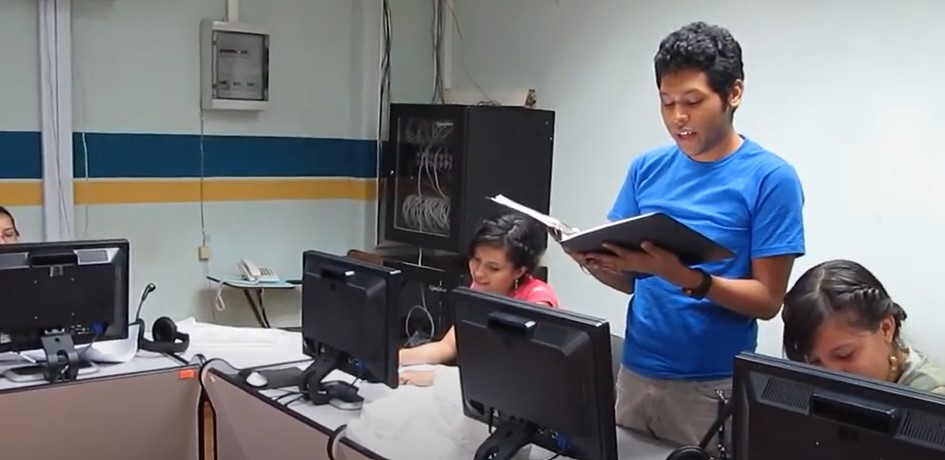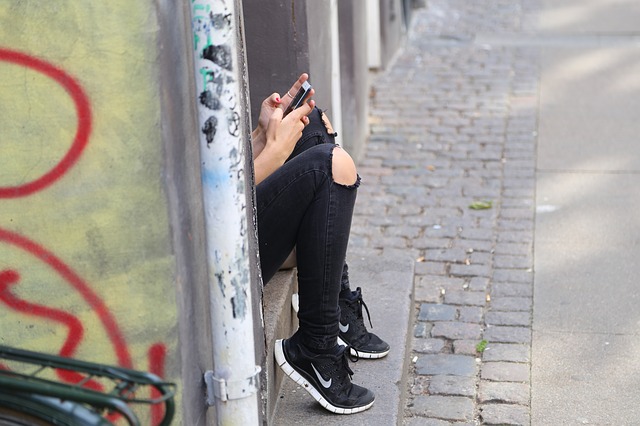There are some lessons that I rely on as a teacher for their success with students at many different levels, usually with minimal adaptation required. The lesson below is one of them; students take to the prompt quickly and with little resistance, possibly because the prompt provides room for personalization without feeling intimidating. I think of this lesson as one that breaks students open—it is accessible and easy to execute, and I’ve had wonderful results teaching it over many years.
I start with the poem “Datos Personales” (scroll to the penultimate poem in this link) by a hero of mine, Nicaraguan/Salvadoran poet Claribel Alegría. I usually ask a student who is familiar with Spanish, whether a native speaker or someone who wants to try to read the language, to read it out loud.
I then provide my own translation of Alegría’s poem, and, again, ask a student to read it out loud:
PERSONAL RECORDS by CLARIBEL ALEGRÍA
I am 1.5 meters tall.
(trans. Sheila Maldonado)
Eyes brown.
Do I dare to laugh,
to ask,
to destroy the armor
they’ve put on me
and scream from shame?
I know how to read and write
but have not been able
to forget my rages.
I was never in jail.
Why so many passwords
if it’s more difficult than before
to know each other?
At night
what I’ve said hurts.
In dreams
I disguise myself.
I live an absurd role
the script of which I forget.
A number identifies me
and I drown from thirst.
Despite everything
the song rises up
and they don’t know what
to do in customs
and set it free.
Once we are done reading, I start asking some questions to help students think more deeply about the poem. I ask, where do you think the poet is? Do you think she’s comfortable where she is; is she happy? When students reply in the negative, I ask what makes them say so. What does the poet say to give us the sense that she is not happy or comfortable? I direct their attention to the fact that she talks about rages, and about jail, but then also makes it a point to say that she was never in jail. Then what is it that makes her feel as if she is? We make note of some of the phrases—’scream from shame’, ‘destroy the armor’, ‘I disguise myself’—that help the reader understand that the poet is in a place that feels somehow oppressive.
We notice together that the poem begins with descriptions—’1.5 meters tall, eyes brown’—that sound like they belong in some kind of official document. I ask the students, what does that read like? They say: passports, or licenses; the kind of documents that identify you. Then I redirect their attention to the title—Personal Records. By now we understand that the poet is writing from some kind of documentation—perhaps an ID card that she has to present at checkpoints, as was common in Central America for a long time and still is to some degree. This part of the poem gives us descriptions of the poet that seem somehow cold and impersonal, but soon she transitions to something more interior—’at night what I’ve said hurts’, ‘In dreams I disguise myself.’ We note that there is a lot of concealment that seems to be happening within the poem, and that helps us transition into a larger conversation about what it is like to live in an oppressive society. I give some background on the dictatorship in Nicaragua that Alegría’s family had to escape, and how she lived to see its revolutionary period as well. After we have discussed the poem for some time—usually around twenty minutes—I transition to the second part of the lesson, which involves giving students a model that they can emulate.
When I began as a teaching artist 20 years ago with the Poetry Outreach program at The City College of New York, I was introduced to this part of the lesson. I came across these student poems in CCNY’s Poetry in Performance anthology in 2002. Later I found the poem by Claribel Alegría, and thought that it complemented the student poems perfectly. Here is the first student poem of the two I teach as part of this lesson at the college-level:
MY SELF-PORTRAIT
I’m 12 years old
and I wear glasses and don’t
talk to nobody.
I’m 5 foot 3 and I weigh 90 pounds.
I’m in the sixth grade.
I’m weird and happy and
sad at the same time.
My eyes are light brown, and my hair
is the same color as my eyes.MY SECRET SELF-PORTRAIT
I feel so trapped inside,
Yordenis, 6th grade
but I have peace on my face.
I love to eat candy and Chinese food.
I’m wild like a lion and sweet as
a butterfly.
Immediately we can see that this poem is, in a way, a more broken-down version of Alegría’s poem—here, the exterior and interior descriptions are in their own separate categories. We read the first part of the poem, and notice that, like Alegría’s poem, Alvarez begins with numbers—12 years old, 5 foot 3, 90 pounds, sixth grade. This part of the poem reads like a kind of record. There’s some personal detail in this section, but for the most part, the description is external and somewhat superficial, like how you might describe yourself to a stranger. Then we move on to the ‘secret self-portrait’, and now it is obvious that we are hearing about the more personal details that one is usually reluctant to share. We note that the poet feels ‘trapped’, although we don’t know why. We see that she uses a little simile to describe herself—’wild like a lion and sweet as a butterfly’. Students begin to realize that, to put it in the simplest terms, the ‘self-portrait’ is external while the ‘secret self-portrait’ is more internal.
We then read the second of the student poems:
MY SELF-PORTRAIT
I have black hair that
curls like the number 3.
I’ve got brown eyes
that you can see into.
It feels soft.
I see light in my eyes.
My neck is soft.
The color of my neck
is light brown.
I’m 5 feet and 1 inch.
I love to put on makeup
to match with my clothes.
My arms are light brown
with white.MY SECRET SELF-PORTRAIT
I am Arabic.
Nisreen, 6th grade
I want to walk again
with my family.
I’ve lost how my sister looks,
but I still have her smell.
One of the first things we note together is how being Arabic is part of this poet’s secret self-portrait. I ask the students why they think this is, and we discuss possible reasons: perhaps she feels separate from other people around her, or perhaps she’s mocked for being different. Where is she, that she would feel the need to hide her identity? Why is she without her family? The students take guesses: maybe her family is in another country, and she has had to be separated from them. We look at the final lines about the sister—some students wonder if the sister is dead, or if she is simply far away. We notice together how intimate and somehow beautiful these final lines are, with the author sharing some of her thoughts and withholding others. I tell students that they can do the same: reveal some part of themselves, without feeling like they have to reveal everything.
I then show them my own version of this prompt, which appeared in my first book one-bedroom solo:
MY SELF-PORTRAIT
I’m 29 years old
and I wear contacts
and don’t talk to nobody.
I’m 5 foot 6 and I weigh,
well I can’t say.
I’m in the 18th grade
I’m weird and happy and sad
all at the same time.
My eyes are plain brown and my hair
is the same color as my eyes.
In the summer my hair changes color.
My eyes look lighter in the light.MY SECRET SELF-PORTRAIT
My skin is my secret weapon.
It’s soft and comforting like a teddy bear.
I’m this close to losing it always.
I understand those who do
but if I hang around them too long
I really will lose it and
I think I just want to be close to losing it
not actually doing it.
Everything seems like luck to me.
Even my life is made up of a
good amount of good luck.
Some get more than others.
It’s up to you how you feel about that.
Sometimes I’m jealous
and then I’m mad at me for being jealous.
I think that’s a religious thing
even though I never did my Communion
and will probably burn in hell
but I supposedly don’t know enough
to believe in all that.
I have my own private talks with my god
who has always been my friend.
There’s a ray of light that goes from me
up to the sky wherever my god is
that’s how we communicate.
I point out that this writer—it’s helpful to treat myself as just another writer in the classroom—used this format to focus on the things they secretly believe, more even than their fears and dreams. This helps to illustrate to the students that they can approach this form in many ways—I even tell them to feel free to borrow from any of the examples I’ve shared to get started.
I give them about five minutes for the ‘self-portrait’ part of the poem, and then we break and turn our focus to the ‘secret self-portrait’—I ask them, what are you afraid of? What do you like deeply? What do you believe in? After the students are done writing, some volunteer to share their poems, or the parts of their poems that they are comfortable sharing.
One of the reasons I think this lesson is so successful is because the form—divided cleanly into two parts—provides something of a neat container for the students’ emotions. It helps them feel like they can open up in their writing without feeling as if they need to expose everything about themselves at once—too much pressure to reveal can often lead to students feeling uncomfortable or even violated, and a form like this can help prevent that and create a more supportive classroom experience. I think students see that this is a form which gives them the space for a little bit of confession but protects them from feeling too exposed. It allows them to conceal as they reveal. They learn to be specific yet create mystery and engage emotion, the many ways of poetry. Young writers often want someone to give them direction without making them feel constrained, and a template like this can strike that balance.
When I’m teaching this lesson to younger students, I sometimes leave out the Claribel Alegría poem and instead approach the lesson almost like an assignment. I ask them to give me five descriptions of themselves from the outside: What color are their eyes? How long is their hair? Do they wear glasses? Then for the ‘secret self-portrait’, I tell them that they can try making a list of five things they fear, or five things they dreamed about recently. Through those questions students can slowly arrive at the truths about themselves that they had so far been unwilling to share, and together find the courage to put them in writing.
Here are some poems that my students have written over the years, and they might serve as useful models for your students too.
This first example was written by a student in my community college creative writing class in the first few months of the Trump administration. She was pulled off a bus in the Bronx by ICE and detained for about a day.
MY SELF-PORTRAIT
I am twenty years old,
wearing a black head wrap.
I am five foot seven inches
and a half.
My skin is tan, my lips are big,
my nose is broad,
my eyes are dark and small.
I can’t smile without seeing my tooth gap.
My outfit is cheap.
By my look, you can’t tell if I am Black,
Latina, Muslim or Christian.MY SECRET SELF-PORTRAIT
I am big as my hopes and dreams.
Seidy D. (Borough of Manhattan Community College)
I don’t know what people think about me,
based off my look.
Though you ask me if I care.
Well, I didn’t until I was pulled off
of a public bus by a White ICE officer,
who I could tell by his tone, was confused.
I was asked about my recent travels.
I was requested to prove my legal status
in the land of freedom.
I am a human, I believe in something
bigger
than myself, not a saint or a church.
I am exhausted, triggered, bothered.
I feel the impulsivity running like blood
through my veins.
I, an open mind and a sweetheart.
I, a pure soul.
I, a daughter, a sister, a girlfriend, a friend,
can’t do shit for any of these people
who I am related to.
I am sorry for all of them.
I, just like millions of other people have a
dream,
a hope, a prayer, a wish, a goal,
and we share an enemy.
I live in the land of “What’s your social?”
and “Where is your ID?”
I keep asking myself, are we even
really free?
This self-portrait / secret self-portrait was written by a student in a college classroom that I visited and taught in Tegucigalpa, Honduras, my family’s homeland, almost a decade ago. Read below and watch him read it here:
MY SELF-PORTRAIT
I’m 20.
I’m 5’6’’ but I don’t look too tall.
I’m overweight but I don’t look too chubby.
I have thick, black hair I never comb.
My eyes are average brown
And my skin is like caramel.
My smile is happy and carefree
But my eyes are sad and sober.
My youth is my treasure.MY SECRET SELF-PORTRAIT
I could fool anyone at first sight.
Luis Jancarlos Montoya
I look like the prey but in fact, I’m the hunter.
My hunger is only noticeable at night, in the dim light, shining in my dark eyes.
My ambition knows no limits
But my fear is the thought of not having enough time
To do what I want.
I look for love but sometimes, I just lay and wait for it to find me.
Sometimes I go to bed thinking: “Hmm, under that rock, I should’ve checked twice.”
But in the morning, I forget.
I love the sun and the heat, I feel like a tourist in my own lands.
I take life with my already full hands.
Universidad Pedagógica Nacional Francisco Morazán
Tegucigalpa, Honduras, March 2012
These last two pieces were written about seven years ago during a Teachers & Writers residency I led for a fourth grade in the Bronx.
MY SELF-PORTRAIT
I’m 10 years old
I have dirty-blond hair
that is very wavy
like rivers
I have hazel-green eyes
that change color
I look more like my dad
I have two sisters
and one brother
who are nice
I love clothing
that looks like Lady Gaga
would wear themMY SECRET SELF-PORTRAIT
I never remember
Arianna C. (4th grade)
my dream because
I wake up too early
I am as sensitive as china
I fear the day I die
I do not want to die
because I will
be leaving behind
everyone and everything
I have and love
I wish to be
rich and famous
and say ‘goodbye’
before I go
MY SELF-PORTRAIT
I am caramel color
I am 4 foot 5
I am 10 years old
I weigh 114 pounds
I play football and kickball
My real eye color
is brown as a football
I am a lone wolf
I don’t have a pack but if I did
I would be the leader
I am fast as a cheetah
chasing its prey
I am dangerous like a lion
I wear glassesMY SECRET SELF-PORTRAIT
I am very secretive
Naiquan T. (4th grade)
also tall and creepy
Scary too
My dark side overpowers me
I try to hold it in
My friends do not know
I have a dark side
I’m evil as humanity
I’m very gentle with animals
I also don’t believe in the devil
I live with God on my side
Sheila Maldonado is the author of the recently released poetry collection That's What You Get (Brooklyn Arts Press, 2021) as well as One-bedroom Solo (Fly by Night Press / A Gathering of the Tribes, 2011), her debut poetry collection. She is a CantoMundo fellow and a Creative Capital awardee as part of desveladas, a visual writing collective. She teaches English for the City University of New York. She was born in Brooklyn, raised in Coney Island, the daughter of Armando and Vilma of El Progreso, Yoro, Honduras. She lives in El Alto Manhattan.



